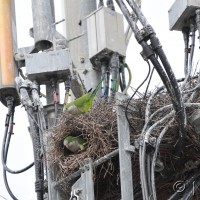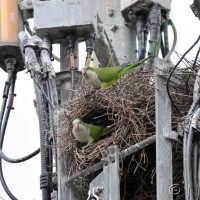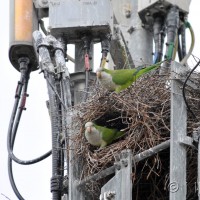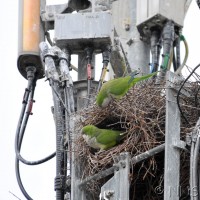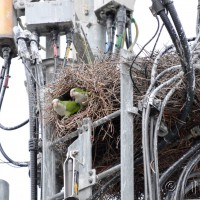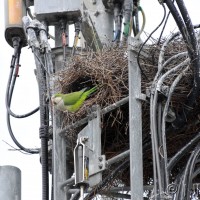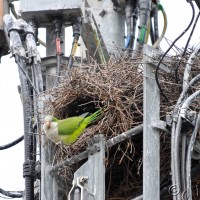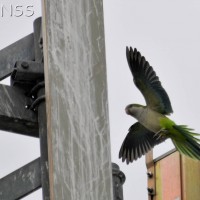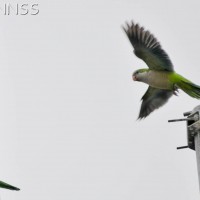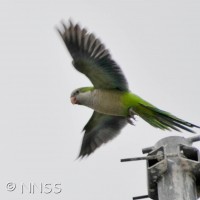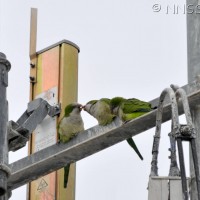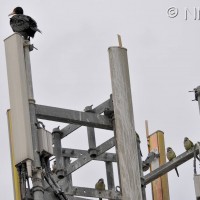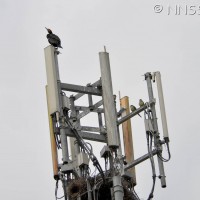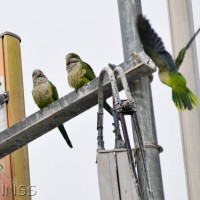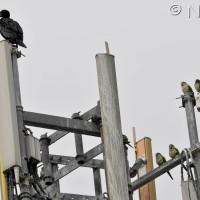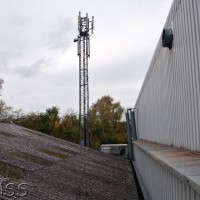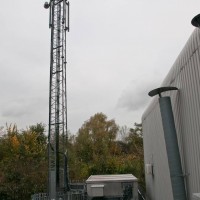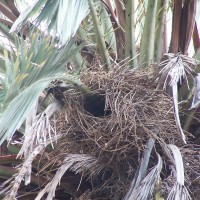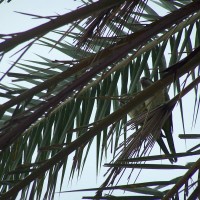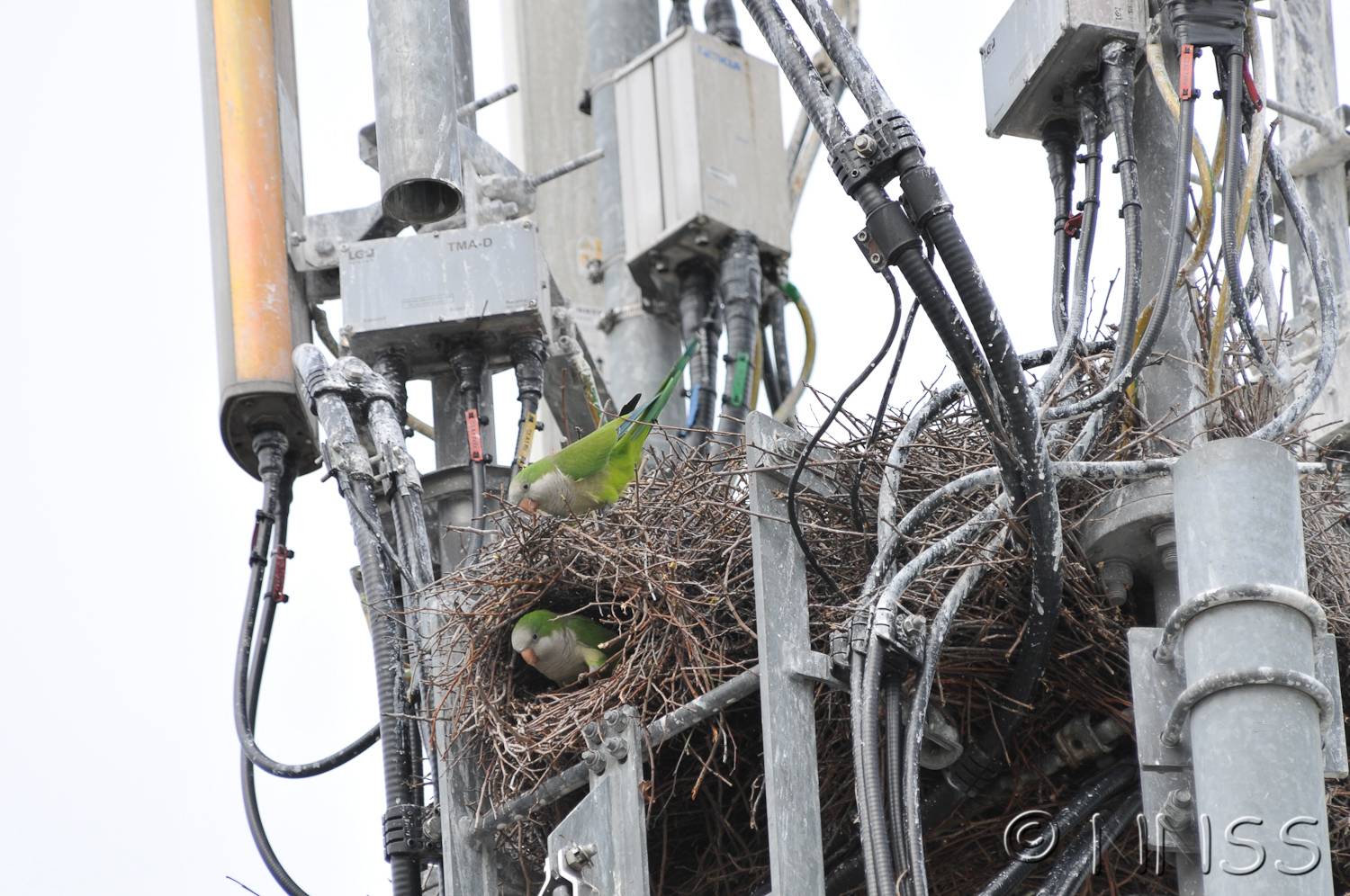
Monk Parakeet - Myiopsitta monachus
Expand and collapse the sections below by clicking on the title or + / - icons.
Short description of Myiopsitta monachus, Monk Parakeet
Monk parakeet is a noisy, long-tailed, long-winged parrot, smaller than ring-necked parakeet but larger than budgerigar – mainly bright green, with pale ash-grey forecrown, face and breast. The flight feathers of the wing are dark blue, the bill orange and the feet pinkish-grey.
Impact summary: Myiopsitta monachus, Monk Parakeet
Well-established introduced populations elsewhere have had significant economic impact, and effects on ecosystems and human health, but there have been no similar reports as yet from GB.
Habitat summary: Myiopsitta monachus, Monk Parakeet
There are isolated breeding colonies in London and Hertfordshire, but individuals might be met with elsewhere – especially if a potential source of escapes is nearby. In its natural range the species is able to nest in young woodland, including eucalyptus plantations, where it can avoid competition with hole-nesting parrot species, which mostly require the presence of large, old trees. Introduced populations have thrived in urban areas.
Overview table
| Environment | Terrestrial |
|---|---|
| Species status | Non-Native |
| Native range | Brazil, Argentina Distrito Federal, Bolivia, Paraguay, Uruguay |
| Functional type | Herbivore |
| Status in England | Non-Native |
| Status in Scotland | Non-Native |
| Status in Wales | Non-Native |
| Location of first record | New Forest |
| Date of first record | 1899 |
Origin
The species is native widely across central regions of South America, and is generally abundant, inhabiting grassland, scrub and forest regions. It breeds readily in captivity and has been traded worldwide in very large numbers as a cagebird.
First Record
The first known release into the wild in GB was of 31 birds at Whipsnade in 1936. Breeding colonies have been known in the wild in GB since the 1970s.
Pathway and Method
CITES reports that 5,215 birds were imported into the UK between 1975 and July 2007. Argentina alone is reported by CITES to have exported more than 200,000 birds during a recent 25-year period. Many more birds in captivity will have been captive-bred. Birds in captivity occasionally escape, and deliberate releases, although illegal, may also be occurring, for example when owners no longer feel able to look after their pets.
Species Status
The present status in GB is that occasional individuals may occur widely, usually near human habitation, mostly as recent escapes from captivity. Breeding colonies have been recorded as far north as Huddersfield, but most have been unsuccessful. There are breeding colonies currently in London and Hertfordshire. Self-sustaining or invasive feral populations occur widely in the Americas and Europe, and in Israel and Japan.
Dispersal Mechanisms
Dispersal has occurred widely through aviculture and the international trade in wild birds. Natural rates of dispersal are low. They are considered largely sedentary and will often not forage at distances beyond 1.5 km (Butler 2005). Although natural spread is slow, further escapes and releases significantly boost the rate of range expansion (Martin & Bucher 1993, Hyman & Pruett-Jones 1995). In the USA, populations are expanding exponentially, doubling every 6–7 years (Pruett-Jones et al 2007). Numbers are especially high in Florida and in the New York region. Control measures in the early 1970s reduced the population by about 50% by 1975 but were then abandoned. Spain holds a large and widespread population, which is expanding exponentially, with much suitable habitat as yet uncolonised (Muñoz & Real 2006). In Catalonia, the population is doubling at intervals of about 9 years. The first known records in Spain were in Barcelona in 1975.
Reproduction
Uniquely for a parrot, this species builds stick nests rather than nesting in holes. Colonies build communal stick structures, which can grow to several cubic metres in volume, with a separate entrance and chamber for each pair. These nests are typically built in trees, but also on manmade structures, such as electrical substations and power poles, and (in the native range) in cliff fissures. Breeding can occur almost year-round, with several broods per pair.
Known Predators/Herbivores
In GB, nest predators might include squirrels but predators of the adults would be limited to cats and birds of prey.
Resistant Stages
None known.
Habitat Occupied in GB
Monk parakeets in GB occur in urban, suburban or semi-rural settings, mostly close to likely sources of escapes or releases of captive birds. Unlike most parrots, which nest in holes, this species is not dependent on large trees for nesting.
Free-living colonies have arisen in Devon, London and Hertfordshire. Records elsewhere are likely to refer to recent escapes.
Environmental Impact
Davis (1974) reported that monk parakeets had been observed killing native birds in the USA, and it is likely that competition for food would limit resources available for native species. Monk parakeets frequently dominate areas where food has been provided for wild birds (South & Pruett-Jones 2000).
Health and Social Impact
In an urban setting, some people may feel that the large nests are unsightly and that the noise that monk parakeets produce constitutes a serious nuisance (Davis 1974). Monk parakeets can also carry diseases that could be passed on to wild birds and poultry (Newcastle disease) or humans (psittacosis), where a pathway of transmission exists (Stafford 2003).
Economic Impact
The monk parakeet is considered to be an agricultural pest in Uruguay (Mott 1973) and elsewhere in its native range (Navarro et al 1992). It is also becoming an agricultural pest in Florida (Tillman et al 2000) and has been observed damaging crops in New Jersey, New York, Ohio and California (Davis 1974).
Identification
Juniper, T. & Parr, M. (1998) Parrots: a guide to the parrots of the world. Pica Press, Robertsbridge.
Biology, ecology, spread, vectors
Butler, C. (2002) Breeding parrots in Britain. British Birds, 95, 345–348.
Eberhard, J.R. (1996) Nest adoption by monk parakeets. Wilson Bulletin, 108, 374–377.
Eberhard, J.R. (1998) Breeding biology of the Monk Parakeet. Wilson Bulletin, 110, 463–473.
Gabb, R., Steventon, D.J., Turner, J.E. & Turner, M.G. (1994) Cheshire & Wirral Bird Report, 1993, 78.
Grant, K.R. (1996) Devon Bird Report, 1995, 68.
Holling, M. & the Rare Breeding Birds Panel (2007) Non-native breeding birds in the United Kingdom in 2003, 2004 and 2005. British Birds, 100, 638–649.
Hyman, J. & Pruett-Jones, S. (1995) Natural History of the Monk Parakeet in Hyde Park, Chicago. Wilson Bulletin, 107, 510–517.
Long, J.L. (1981) Introduced Birds of the World. David and Charles, London.
Lever, C. (1987) Naturalized Birds of the World. Longman Scientific & Technical, Harlow, UK.
Martin, L.F. & Bucher, E.H. (1993) Natal dispersal and first breeding age in monk parakeets. Auk, 110, 930–933.
Muñoz, A.R. & Real, R. (2006) Assessing the potential range expansion of the exotic monk parakeet in Spain. Diversity and Distributions, 12, 656–665.
Navarro, J.L., Martella, M.B. & Bucher, E.H. (1992) Breeding season and productivity of monk parakeets in Córdoba, Argentina. Wilson Bulletin, 104, 413–424.
Sol, D., Santos, D.M., Feria, E. & Clavell, J. (1997) Habitat selection by the monk parakeet Myiopsitta monachus during the colonization of a new area. Condor, 99, 39–46.
South, J.M., & Pruett-Jones, S. (2000) Patterns of flock size, diet, and vigilance of naturalized monk parakeets in Hyde Park, Chicago. Condor, 102, 848–854.
Van Bael, S. & Pruett-Jones, S. (1996) Exponential population growth of Monk Parakeets in the United States. Wilson Bulletin, 108, 584–588.
Wilson, A.M. & Slack, R.S. (1996) Rare and scarce birds in Yorkshire. Privately published.
Management and impact
Avery, M.L., Greiner, E.C., Lindsay, J.R., Newman, J.R. & Pruett-Jones, S. (2002) Monk Parakeet management at electric utility facilities in South Florida. In Proceedings of the 20th Vertebrate Pest Conference (eds R.M. Timm & R.H. Schmidt), pp. 140–145. University of California, Davis. (full text)
Bucher, E.H. (1992) Neotropical parrots as agricultural pests. In New World Parrots in Crisis: solutions from conservation biology (eds S.R. Beissinger & N.F.R. Snyder), pp. 201–219. Smithsonian Institution Press, Washington, DC.
Davis, T.R. (1974) The Monk Parakeet: a potential threat to agriculture. In Proceedings of the 6th Vertebrate Pest Conference, pp. 253–256. University of California, Davis, CA.
Defra website, updated 21 Jan 2008: Avian influenza (bird flu): Kept birds.
Manchester, S.J. & Bullock, J.M. (2000) The impacts of non-native species on UK biodiversity and the effectiveness of their control. Journal of Applied Ecology, 37, 845–864.
Mott, D. (1973) Monk parakeet damage to crops in Uruguay and its control. Proceedings of the Bird Control Seminar, 6, 79–81.
Pruett-Jones, S., Newman, J.R., Newman, C.M., Avery, M.L. & Lindsay, J.R. (2007) Population viability analysis of monk parakeets in the United States and examination of alternative management strategies. Human–Wildlife Conflicts, 1, 35–44.
Simberloff, D. (2003) How much information on population biology is needed to manage introduced species? Conservation Biology, 17, 83–92.
Tillman, E.A., Van Doorn, A. & Avery, M.L. (2001) Bird damage to tropical fruit in south Florida. Proceedings of the Wildlife Damage Management Conference, 9, 47–59.
General
BirdLife International (2008) Species factsheet: Myiopsitta monachus. Downloaded from http:www.birdlife.org on 552009
Forshaw, J.M. (2010) Parrots of the world. Christopher Helm, London.
Lever, C. (2009) The Naturalized Animals of Britain and Ireland. New Holland Publishers, London.
Spreyer, M.F. & Bucher, E.H. (1998) Monk parakeet (Myiopsitta monachus). Birds of North America, 322, 1–23.
https://www.cabi.org/isc/datasheet/74616
https://secure.fera.defra.gov.uk/nonnativespecies/downloadDocument.cfm?id=1747
Alert status
Monk Parakeet, Myiopsitta monachus is an Alert Species
Find more information about this alert and the full list of alert species.
Spotted this species?
Distribution map
View the Distribution map for Monk Parakeet, Myiopsitta monachus from NBN Atlas

Native range map
View an interactive native range map for Monk Parakeet, Myiopsitta monachus
ID Sheet
ID Sheet for Myiopsitta monachus . See a full list of non-native species ID Sheets.
Risk assessment
Risk assessment for Myiopsitta monachus. See a full list of non-native species Risk assessments.

